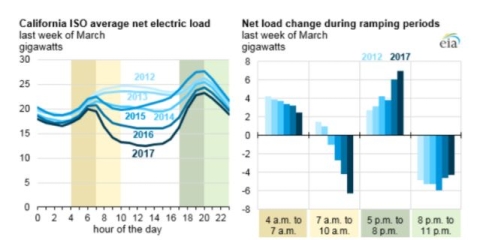
California has a major duck problem. Though this problem has nothing to do with waterfoul. The “duck curve” is a phenomenon that has become increasingly problematic in recent years, as more solar power has come on line. The problem with so much solar is that it generates the most electricity mid-day when the sun is most intense. However, this doesn’t align very well with typical use patterns, as millions of Californians come home from work in the late afternoons and turn on lights, air conditioning, and appliances. This leads to a glut of cheap renewable energy during mid-day and extra strain in the evenings (the resulting time versus net electric grid load graph looks like the silhouette of a duck—hence the name).
Now, new data from the US Energy Information Administration has found that, as California continues to invest in clean solar energy, the resulting duck curve is getting even more pronounced. This is a problematic trend, as bringing new generating capacity online in the evenings is costly and can come from power plants that emit vast quantities of CO2 and other pollutants.
However, there are solutions! And while batteries or other energy storage technologies often come to mind as a great way to capture solar power for use later in the evenings, the cheapest fix is actually through the twin approaches of energy efficiency and demand response.
Energy efficiency is a potent tool in fighting the duck curve because it has the potential to lower electric customers’ needs at all times of the day. This not only saves customers money but shrinks the entire duck curve, including the problematic late afternoon peaks. Meanwhile, demand response is the practice of utility customers specifically curtailing electric loads right at the height of a demand peak. This too can save money and is a powerful way to “flatten” the curve out. Today, most demand response efforts are limited to commercial customers who might adjust HVAC setpoints or lighting levels based on signals from the utility. But the proliferation of communicating consumer technologies from smart thermostats to connected lighting mean that residential households are increasingly equipped to participate in such programs. In the not-too-distant future it may be possible for residential customers to opt their homes into a demand response program that seamlessly optimizes and adjusts home energy usage without a homeowner even having to think about it. This not only could translate to an appealing utility rebate for the customer, but a more reliable grid and the squashing of that problematic (and growing!) duck curve.
You can read more about the EIA's research on Califiornia's worsening duck curve here: https://www.greentechmedia.com/articles/read/eia-charts-californias-real-and-growing-duck-curve
